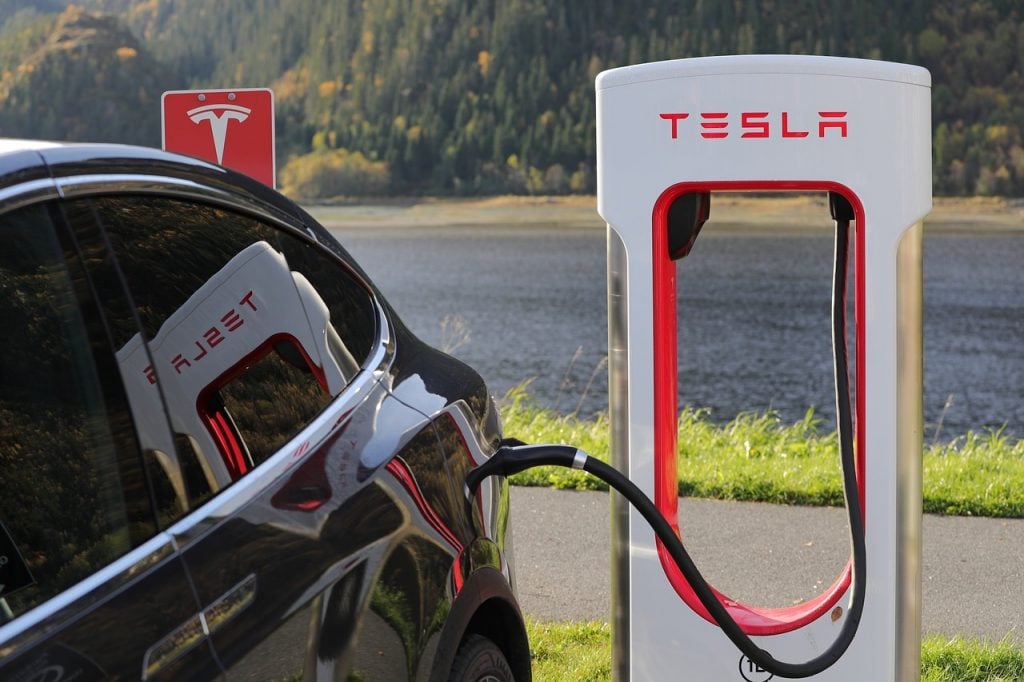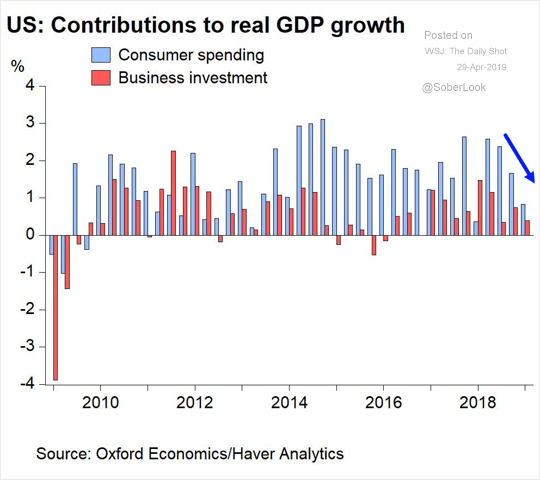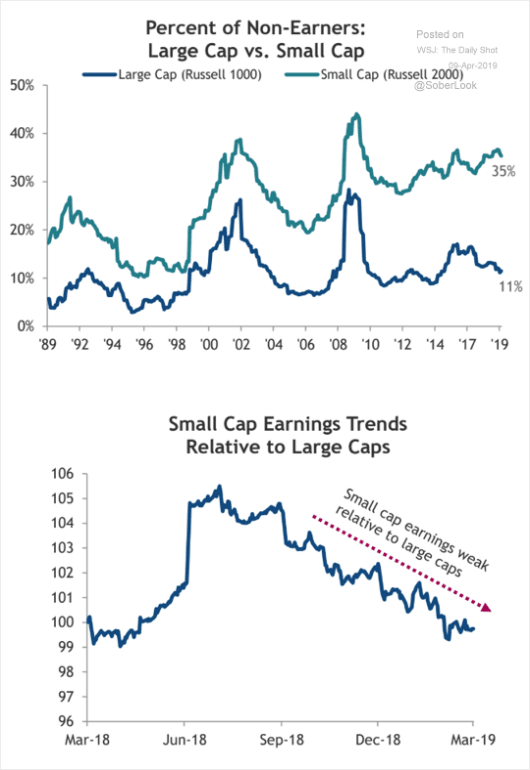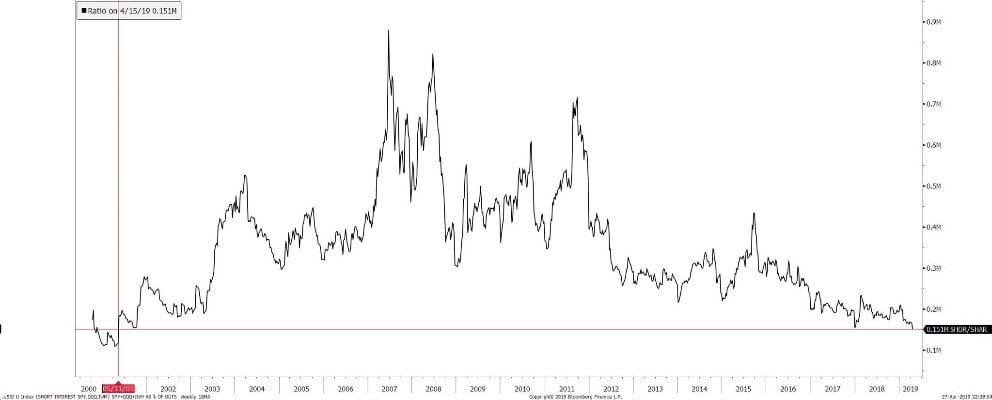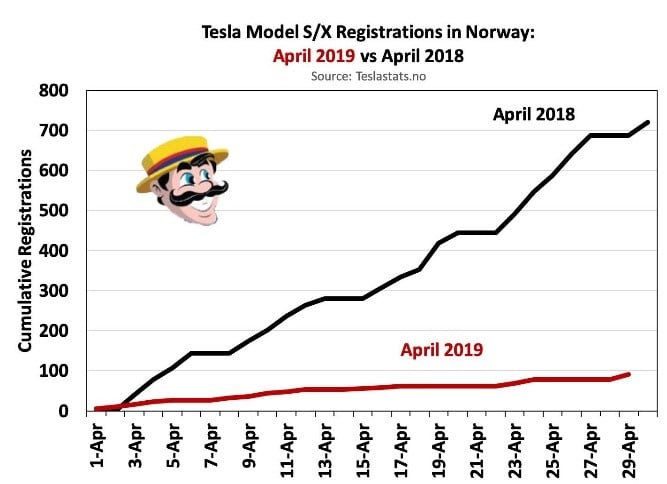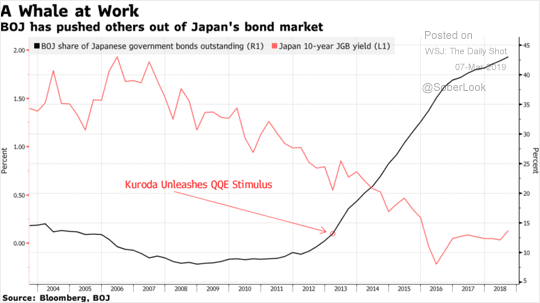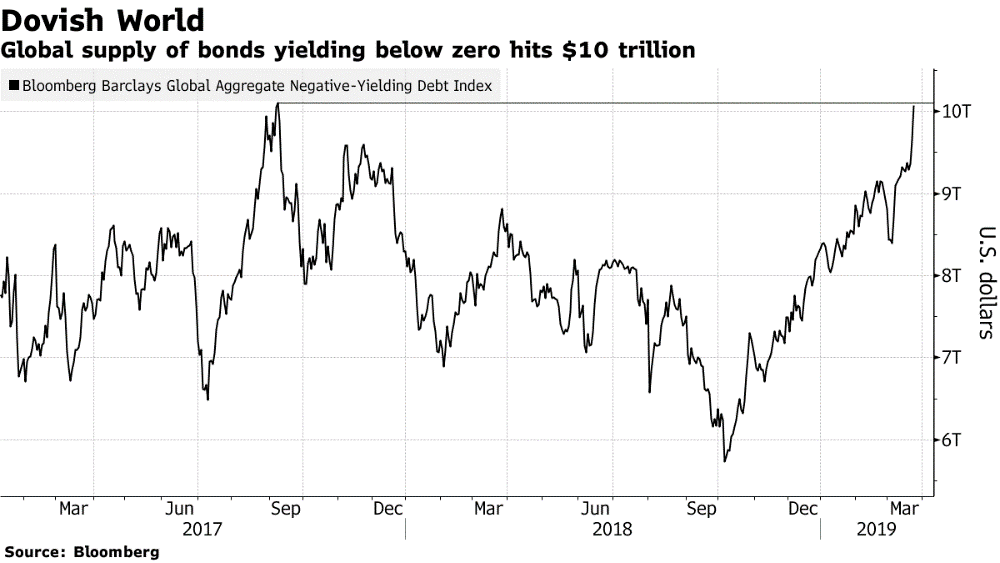Stanphyl Capital letter to investors for the first quarter ended March 31, 2019, discussing their short stock and call options in Tesla Inc (NASDAQ:TSLA).
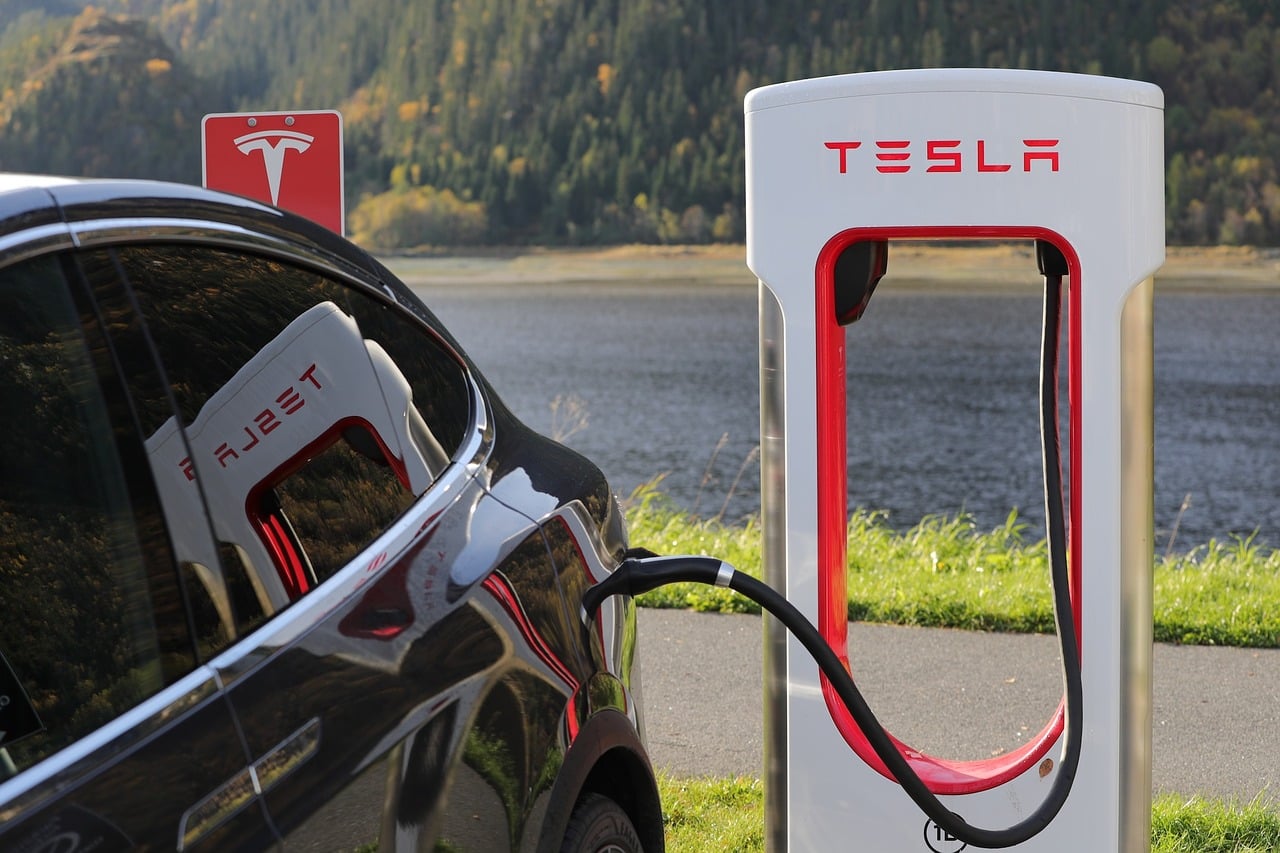
Friends and Fellow Investors:
For April 2019 the fund was up approximately 2.9% net of all fees and expenses. By way of comparison, the S&P 500 was up approximately 4.0% while the Russell 2000 was up approximately 3.4%. Year-to-date 2019 the fund is up approximately 16.0% while the S&P 500 is up approximately 18.2% and the Russell 2000 is up approximately 18.5%. Since inception on June 1, 2011 the fund is up approximately 90.8% net while the S&P 500 is up approximately 158.5% and the Russell 2000 is up approximately 109.3%. Since inception the fund has compounded at approximately 8.5% net annually vs 12.8% for the S&P 500 and 9.8% for the Russell 2000. (The S&P and Russell performances are based on their “Total Returns” indices which include reinvested dividends.) As always, investors will receive the fund’s exact performance figures from its outside administrator within a week or two. (Please note that individual partners’ returns will vary in accordance with their high-water marks.)
Q1 hedge fund letters, conference, scoops etc
I continue to believe that what we’ve seen since the market’s late December low is a bear market rally (albeit a fierce one), with the broad indexes in the process of forming a double-top like those of 2000 and 2007. The U.S. economic slowdown is in its early stages and we’re a long way from QE4; in fact the Fed is still removing approximately $50 billion a month from its balance sheet and—despite the taper announced in March—will continue removing tens of billions of dollars a month through September, while real short-term U.S. interest rates are positive for the first time in over a decade. Meanwhile, as evidenced by the chart below, Q1’s annualized +3.2% GDP report was much weaker than the headline number suggests:
We thus remain short the Russell 2000 (IWM), an index with a trailing twelve-month GAAP PE ratio of 43, and a declining “E” with 35% of its constituents losing money:
Is our short bias a contrarian one? It certainly seems to be, as here (courtesy of Real Vision Research) is a chart of the current (as of mid-April) combined short interest in SPY, QQQ and IWM as a proportion of all shares outstanding:
Elsewhere in the fund’s short positions…
We remain short stock and call options in Tesla Inc (TSLA), which I consider to be the biggest single stock bubble in this whole bubble market. The core points of our Tesla short thesis are:
- Tesla has no electric vehicle “moat” of any kind; i.e., nothing meaningfully proprietary in terms of design or technology, while existing automakers—unlike Tesla—have a decades-long “experience moat” of knowing how to mass-produce, distribute and service high-quality cars consistently and profitably.
- Tesla is now a “busted growth story”; demand for its existing models has peaked and it will have to raise billions of dollars to produce new ones.
- Tesla is losing a ton of money with a terrible balance sheet while suddenly confronting massive competition in every aspect of its business
- Elon Musk is extremely untrustworthy.
In April Tesla reported a disastrous Q1, with a GAAP loss of $702 million (over $900 million excluding regulatory credit sales) and just 63,000 vehicles delivered, down 30% sequentially from Q4 of 2018. Model 3 sales were down 17% despite the initial, backlog-filling sales into Europe and China, while sales of the much higher-margin S&X were down an astounding 52%, and this all happened despite massive price cuts on every model as the quarter progressed.
In the Q1 earnings press release the company blatantly lied about its Q2 guidance, claiming it will sell 90-100,000 cars when in fact it will only approximately match the delivery number from Q1, and at a much lower ASP. I thus predict that Q2’s loss will be roughly as bad as Q1’s, with lower ASP’s and regulatory credit sales offsetting Q1’s inventory write-down. (The only wild card will be if Tesla recognizes some deferred Autopilot revenue, in which the loss should still be at least $500 million.)
Following April’s awful deliveries report, word leaked that Panasonic was refusing to commit any more investment to Tesla’s Nevada battery factory, nor would it invest in Tesla’s future plant in China.
The party’s over, folks. With no growth, massive ongoing losses and tens of billions of dollars in debt and purchase obligations, the equity in Tesla will prove worthless, either quickly or—following a series of increasingly ugly capital raises—slowly. But as the stock price has yet to reflect that, I’ll continue…
Q1 Model S&X sales (Tesla’s highest-margin cars) were especially awful in Europe, and Q2 looks no better:
European S&X sales are being crushed by the recently introduced Audi e-tron and Jaguar I-Pace (the Jaguar is currently available in the U.S. and the Audi arrives in May) , and later this year come the Mercedes EQC and Porsche Taycan, with multiple additional electric Audis, Mercedes and Porsches to follow, many at starting prices considerably below those of the luxury Teslas. (See the links below and last month’s letter for more details.)
As for the Model 3, Tesla in March claimed to have finally introduced a $35,000 version, but then after grabbing a bunch of deposits to pad the March 31 balance sheet decided to make it only “available” at its (increasingly shuttered) physical stores. (No wonder, as the car uses a larger battery pack that’s software-limited and thus Tesla will lose thousands of dollars on each one it sells.) Meanwhile the cheapest Model 3 available for on-line ordering now costs $39,500 and reflects yet another price cut (the fourth this year, by my count), as it includes basic Autopilot as part of a $2000 price increase, yet that was previously a $3000 option.
Also in April…
- Tesla hosted a laughably bad “Autonomy Day” to show off its (non-existent) self-driving technology. (Keep in mind that in March Navigant consulting came out with its annual ranking of autonomous driving capabilities, and just as last year Tesla ranked dead last among active automakers and suppliers.)
- The SEC gave Musk the wrist-slap we anticipated for his clear contempt violation of the “$420 settlement.” Although this is now irrelevant re Musk as he’s already lied and frauded his way into being a “credibility laughingstock,” it sets an awful example for every other fraud-inclined CEO in America. Nice job, SEC!
- Tesla announced mechanically updated (but stylistically unchanged) versions of the Models S&X with approximately 10% more range than the current models; in my opinion this is nowhere near exciting enough to rekindle the dying demand for those cars.
- Tesla filed a proxy indicating plans to reduce its board size from eleven members to seven, with two leaving immediately and two departing over the next one to two years. Seeing as the entire board is a collection of grotesquely overpaid enablers of Musk’s criminality it’s certainly no great loss, yet on the other hand this further concentrates power in the hands of the Musk family, as Elon and his dim-witted brother Kimbal will now have two seats out of seven as opposed to their prior two out of eleven. And here’s what Tesla shareholders get for their money from their new figurehead of an “independent” Chairwoman:
In mid-March Tesla rushed out an ill-prepared Model Y unveiling on extremely short notice, inspiring its chief engineer to immediately quit. Supposed to be a small electric SUV/crossover, the event showed only a fake clay model and a bodywork-disguised Model 3, and was a complete embarrassment beautifully summarized here by Zero Hedge. By the time the Model Y is available in late 2020/early2021 (if Tesla is still in business then), it will face superior competition from the much nicer Audi Q4 e-tron, BMW iX3, Mercedes EQC and Volvo XC40, while less expensive and available now are the excellent new all-electric Hyundai Kona and Kia Niro, extremely well reviewed small crossovers with an EPA range of 258 miles for the Hyundai and 238 miles for the Kia, at prices of under $30,000 inclusive of the $7500 U.S. tax credit.
Meanwhile, Tesla has the most executive departures I’ve ever seen from any company, a dubious achievement that continued in full-force in April-- here’s the astounding full list. These people aren’t leaving because things are going great (or even passably) at Tesla; rather, they’re likely leaving because Musk is either an outright crook or the world’s biggest jerk to work for (or both). Could the business (if not the stock price) be saved in its present form if he left? Nope, it’s too late. Even if Musk steps down in favor of someone who knows what he’s doing, emerging competitive factors (outlined in great detail below) and Tesla’s balance sheet make the company too late to “fix” without major financial and operational restructuring.
Finally, the Consumer Reports annual auto reliability survey ranks Tesla 27th out of 28 brands and the number of lawsuits of all types against Tesla continues to escalate-- there are now well over 500!
So here is Tesla’s competition in cars (note: these links are continually updated)…
THE NEW ALL-ELECTRIC JAGUAR I‑PACE
VW Group to launch 70 pure electric cars over the next decade
Audi e-tron electric SUV is available now
Audi e-tron Sportback comes late 2019
AUDI E-TRON GT FIRST DRIVE: LOOK OUT, TESLA (available 2020)
Audi's Q4 e-tron previews entry-level EV for 2021
Porsche Electric Taycan Launches Late 2019
Porsche Taycan Cross Turismo to launch in 2020 after Taycan Sedan
The next generation of the Porsche Macan will be electric
New VW ID. hatch: order books for VW electric car open on May 2019
Mercedes EQC Electric SUV Available Mid-to-Late 2019
Mercedes to launch more than 10 all-electric models by 2022
258-Mile Hyundai Kona electric is available now for under $40,000
239-Mile Kia Niro EV is Available Now For Under $40,000
Kia Soul (available mid-2019) EV’s Range Jumps to 243 Miles
Kia Europe to have six pure electric models by 2022
Chevrolet Bolt Offers 238 Miles On A Single Charge
GM is transforming Cadillac into an electric brand
Nissan LEAF e+ with 226-mile range is available now
Nissan Leaf-based SUV coming in 2020
The 2020 Volvo Polestar 2 Is Priced to Beat Tesla’s Best-Selling Model 3
Volvo XC40 full-electric variant to debut later this year
BMW iX3 electric crossover goes on sale in 2020
New BMW i4: Tesla-rivalling coupe seen winter testing
BMW to have 25 electrified models by 2025
Ford’s Mustang-inspired electric performance SUV arrives in 2020 with >300-mile range
Ford Accelerates Its Electric-Vehicle Push With $500 Million Stake in Rivian
Rivian (electric pick-up truck maker) Announces $700M Investment Round Led By Amazon
Peugeot 208 to electrify Europe's small-car market
Toyota, Mazda, Denso create company to roll out electric cars beginning 2019
Toyota to market over 10 battery EV models in early 2020s
New Renault Zoe to feature 400km range
Renault aims to remain EV leader in Europe
Infiniti will go mostly electric by 2021
DS 3 Crossback will give PSA's upscale brand an electric boost
ALL-ELECTRIC MINI COOPER COMING IN 2019
Smart Will Electrify Its Entire Line-up By 2020
SEAT will launch 6 electric and hybrid models and develop a new platform for electric vehicles
Opel/Vauxhall will launch electric SUV and van in 2020
2019 Skoda e-Citigo confirmed as brand's first all-electric model
Skoda planning range of hot all-electric eRS models
New Citroen C4 Cactus to be first electrified Citroen in 2020
MG E-Motion confirms new EV sports car on the way by 2020
Fiat Chrysler bets on electrification for Alfa, Jeep and Maserati
Maserati offering three fully electric cars between 2020 and 2022
Rolls-Royce is preparing electric Phantom for 2022
Honda will offer full-EV or hybrid tech on every European model by 2025
Bentley mulls electric car to help reduce carbon footprint
Subaru to introduce all-electric vehicles by 2021
Korando will lead SsangYong's push into electrification
Dyson Moves Ahead on $2.6 Billion Electric Car Plan
Lucid Motors closes $1 billion deal with Saudi Arabia to fund electric car production
Borgward BXi7 Electric SUV Flies Under The Radar
Detroit Electric promises 3 cars in 3 years
Two new electric cars from Mahindra in India by 2019; Global Tesla rival e-car soon
Saab asset owner NEVS plans electric car production
EV startup Canoo will only sell cars on a subscription basis
And in China…
VW, China spearhead $300 billion global drive to electrify cars
Audi Q2L e-tron debuts at Auto Shanghai
Audi China to roll out 12 locally-produced models in total by 2022
BYD launches EV535, all-electric SUV
BYD Song MAX BEV version with 500km range to hit market in 2019
2019 BYD Yuan EV360 goes on sale with prices starting RMB89,900 after subsidy
Daimler & BYD launch new DENZA electric vehicle for the Chinese market
BAIC and Daimler to Build $1.9 Billion China Plant
BAIC brings EX5 Electric SUV to market
BAIC BJEV, Magna ready to pour RMB2 bln in all-electric PV manufacturing JV
Daimler to Start EQC Electric SUV Production in China in 2019
Daimler and BMW to cooperate on affordable electric car in China
BMW will develop and produce electric Mini in China
GM China raises new-energy vehicle target to 20 models through 2023
Buick Rolls Out First Electric Car for China
Nissan & Dongfeng to invest $9.5 billion in China to boost electric vehicles
Toyota unveils first electric SUVs at Shanghai motor show
Nio’s ES8 Electric Crossover debuts with half the Tesla Model X’s price tag
536 HP Nio ES6 Midsize Electric SUV Launches With 317-Mile Range (at 1/2 the price of Tesla X)
This is NIO’s Tesla Model 3 and Polestar 2 rival
Ford ramps up electric vehicle push in China
Jaguar Land Rover's Chinese arm invests £800m in EV production
SAIC building factory in China for EVs from Roewe and MG
Renault and Brilliance Automotive to build 3 new electric light commercial vehicles for China
Honda launches new all-electric Everus VE-1 for ~$25,000 in China
Honda to roll out over 20 electric models in China by 2025
Geely all-new BEV sedan Jihe A starts at RMB150,000
Geely unveils GE11 compact BEV
New Geely Emgrand GSe crossover has EV range up to 400km
Geely launches new electric car brand 'Geometry'
Changan New Energy to launch three NEV platforms by 2020
Mazda and Changan Auto join hands on electric vehicles
Xpeng Motors G3 Electric SUV Launches in China
Xpeng Motors premiers the P7 intelligent electric coupe
WM Motors/Weltmeister EX5 Electric SUV Launched On The Chinese Car Market
Chery Breaks Ground on $240M EV Factory in China
Chery's second EV plant open in Dezhou
Seres launches production SF5 sleek 684HP electric crossover with 300 miles of range
Byton M-Byte electric SUV tackles cold-weather testing, nears production
DearCC Launches ENOVATE Electric SUV
GAC NE to roll out 12 new models for Aion series, including solar-powered models
Guangzhou Auto To Launch Four New Electric Cars By 2020
Great Wall Launches New EV Brand (ORA) In China
Singulato iS6 Electric SUV Debuts With 249-Mile Range
Singulato, BAIC partner to promote smart new energy vehicles
Hongqi launches E-HS3 BEV SUV with AWD option, 390km range and 0-100kh/h in 5.9 seconds
FAW (Hongqi) to roll out 15 electric models by 2025
JAC Motors releases new product planning, including many NEVs
ICONIQ to build electric cars in Zhaoqing with total investment of RMB 16 billion
Quianu Motor aims to grab share of US electric vehicle market
Hozon Kicks Off Mass Production With All-Electric Neta N01
EV maker Bordrin skips flash, keeps real-car focus
Aiways U5 long-range electric SUV
All-electric NEVS 9-3 sedans (nee Saab) being built in China
Youxia Motors raises $1.25 billion to start 2019 EV production
CHJ Automotive buys Lifan for shortcut to EV production
Infiniti to launch Chinese-built EV in 2022
Wanxiang Gets China Electric Vehicle Permit to Make Karma Cars
Qoros Auto's new owner plans to be an EV power
JMC (Jianling Motor Corp.) Starts New EV Brand In China
Thunder Power Chinese EV manufacturer clinches deal with Belgian investment fund
Leapmotor raises RMB2.5 billion for Series A round to build electric cars
Continental, Didi sign deal on developing EVs for China
Here’s Tesla’s competition in autonomous driving…
Navigant Ranks Tesla Last Among Automakers & Suppliers for Automated Driving
What Smart Tesla fans Get Wrong about Full Self-Driving
Tesla has a self-driving strategy other companies abandoned years ago
Waymo Starts First Driverless Car Service
Jaguar and Waymo announce an electric, fully autonomous car
Waymo Expands Chrysler Self-Driving Fleet 100-Fold to 62,000
Nissan-Renault alliance to tie up with Waymo on self-driving cars
Uber, Waymo in talks about self-driving partnership
Lyft and Waymo Reach Deal to Collaborate on Self-Driving Cars
Cadillac Super Cruise™ Sets the Standard for Hands-Free Highway Driving
Honda Joins with Cruise and General Motors to Build New Autonomous Vehicle
SoftBank Vision Fund to Invest $2.25 Billion in GM Cruise
Ford and VW Discuss Autonomous Car Team-Up at a $4 Billion Valuation
Volkswagen Group and Aurora Innovation Announce Strategic Collaboration On Self-Driving Cars
VW taps Baidu's Apollo platform to develop self-driving cars in China
An Overview of Audi Piloted Driving
Daimler, BMW deepen cooperation with self-driving venture
Mercedes plans advanced self-driving tech for next S class
Daimler's heavy trucks start self-driving some of the way
Volvo, Nvidia expand autonomous driving collaboration
Continental & NVIDIA Partner to Enable Production of Artificial Intelligence Self-Driving Cars
Intel’s Mobileye has 2 million cars (VW, BMW & Nissan) on roads building HD maps
Nissan and Mobileye to generate, share, and utilize vision data for crowdsourced mapping
Magna joins the BMW Group, Intel and Mobileye platform as an Integrator for AVs
Baidu, WM Motor announce strategic partnership for L3, L4 autonomous driving solutions
Baidu plans to mass produce Level 4 self-driving cars with BAIC by 2021
Volvo, Baidu to co-develop EVs with Level 4 autonomy for China
BYD partners with Huawei for autonomous driving
Lyft, Magna in Deal to Develop Hardware, Software for Self-Driving Cars
Deutsche Post to Deploy Test Fleet Of Fully Autonomous Delivery Trucks
Byton cooperating with Aurora on autonomous vehicles
ZF autonomous EV venture names first customer
Magna’s new MAX4 self-driving platform offers autonomy up to Level 4
Groupe PSA’s safe and intuitive autonomous car tested by the general public
Tencent, Changan Auto Announce Autonomous-Vehicle Joint Venture
Self-driving startup Momenta ready to launch fully automated driving solution in Q3 2019
JD.com Delivers on Self-Driving Electric Trucks
NAVYA Unveils First Fully Autonomous Taxi
Fujitsu and HERE to partner on advanced mobility services and autonomous driving
Lucid Chooses Mobileye as Partner for Autonomous Vehicle Technology
First Look Inside Zoox’s Autonomous Taxi
Nuro’s Robot Delivery Vans Are Arriving Before Self-Driving Cars
Here’s Tesla’s competition in car batteries…
LG Chem targets electric car battery sales of $6.3 billion in 2020
LG Chem to build $1.8 bln EV battery plant in China
Samsung SDI Unveils Innovative Battery Products at 2018 Detroit Motor Show
SK Innovation to boost EV battery production capacity more than tenfold by 2022
New Toshiba EV Battery Allows 320km Charge in 6 Minutes
Daimler starts building electric car batteries in Tuscaloosa – one of 8 battery factories
Panasonic Opens New Automotive Lithium-Ion Battery Factory in Dalian, China
Panasonic forms battery partnership with Toyota
CATL’s Chinese battery factory will be bigger than Tesla’s Gigafactory
CATL to set up battery cell manufacturing in Germany
BYD to quadruple car battery output with lithium site plants
GM inaugurates battery assembly plant in Shanghai
Volkswagen plans entry into battery cell production
VW Wants to One-Up Tesla With a Next-Generation Battery
Honda Partners on General Motors' Next Gen Battery Development
Energy Absolute Plots Asian Project Rivaling Musk's Gigafactory
France's Saft plans production of next-gen lithium ion batteries from 2020
Northvolt making ground on Gigafactory in Sweden
FREYR AS to build a 32 GWh battery facility in Norway
Chinese Battery Maker to Open Factory Next to Swedish EV Plant
Sokon aims to be global provider of battery, electric motor, electric control systems
BMW Group invests 200 million euros in Battery Cell Competence Centre
BMW Brilliance Automotive opens battery factory in Shenyang
BMW announces partnership with solid-state battery company
Toyota promises auto battery 'game-changer'
VW increase stake in solid-state batteries with $100M investment
Hyundai Motor developing solid-state EV batteries
Wanxiang is playing to win, even if it takes generations
UK provides millions to help build more electric vehicle batteries
Rimac is going to mass produce batteries and electric motors for OEMs
Elon Musk Has A New Battery Rival (Romeo Power) Packed With His Ex-Employees
Evergrande acquires Cenat battery production
Bracing for EV shift, NGK Spark Plug ignites all solid-state battery quest
ProLogium Technology Will Produce First Next Generation Lithium Ceramic Battery For EVs
Here’s Tesla’s competition in storage batteries…
Panasonic
LG
AES + Siemens (Fluence)
NEC
ABB
Saft
EnerSys
sonnenBatterie (acquired by Shell)
Sharp
Kreisel
Leclanche
UET
ENGIE
Bluestorage
Clean Energy Storage Inc.
Younicos
Powervault
Schmid
24M
Ecoult
Natron Energy
And here’s Tesla’s competition in charging networks…
EVgo Installing First 350 kW Ultra Fast Public Charging Station In The US
Tritium’s First 350-kW DC Fast Chargers Coming To U.S.
Porsche plans network of 500 fast chargers for U.S.
ChargePoint To Equip Mercedes Dealerships With 150kw Charging Stations For EQC
Recargo Ultrafast West Coast Charging
BMW, Daimler, Ford, VW, Audi & Porsche form IONITY European 350kw Charging Network
E.ON to have 10,000 150KW TO 350KW EV charging points across Europe by 2020
Enel kicks off the E-VIA FLEX-E project for the installation of European ultra-fast charging stations
Europe’s Allego “Ultra E” ultra-fast charging network now operational
Allego & Fortum Launch MEGA-E High Power Charging network for Europe’s Metropolitan areas
ChargePoint Secures $240 Million in Additional Funding; $500 million raised in total
UK's Podpoint installing 150kW EV rapid chargers this year; 350kW by 2020
UK National Grid plans 350kW EV charge point network
Fastned building 150kw-350kw chargers in Europe
Deutsche Telekom to build electric car charging network in Germany
ABB powers e-mobility with launch of first 150-350 kW high power charger
Shell buys European electric vehicle charging pioneer NewMotion
BP buys UK's largest car charging firm Chargemaster
Total planning EV charging points at its French stations
VW Is Setting Up Electric Car Charging Stations in China
Yet despite all that deep-pocketed competition, perhaps you want to buy shares of Tesla because you believe in its management team. Really???
Elon Musk Settles SEC Fraud Charges
Elon Musk, June 2009: “Tesla will cross over into profitability next month”
Tesla SEC Correspondence Shows A Pattern Of Inaccurate, Incomplete & Misleading Disclosures
Tesla: Check Your Full Self-Driving Snake Oil Expiration Date
As Musk Hyped and Happy-Talked Investors, Tesla Kept Quiet About a Year-Long SEC Probe
The Truth Is Catching Up With Tesla
With Misleading Messages And Customer NDAs, Tesla Performs Stealth Recall
Who You Gonna Believe? Elon Musk's Words Or Your Own Lying Eyes?
How Tesla and Elon Musk Exaggerated Safety Claims About Autopilot and Cars
When Is Enough Enough With Elon Musk?
Musk Talked Merger With SolarCity CEO Before Tesla Stock Sale
Tesla Continues To Mislead Consumers
Tesla Misses The Point With Fortune Autopilot Story
Tesla Timeline Shows Musk's Morality Is Highly Convenient
Tesla Scares Customers With Worthless NDAs, The Daily Kanban Talks To Lawyers
Tesla: Contrary To The Official Story, Elon Musk Is Selling To Keep Cash
Tesla: O, What A Tangled Web We Weave When First We Practice To Deceive
I Put 20 Refundable Deposits On The Tesla Model 3
Tesla: A Failure To Communicate
Elon Musk Appears To Have Misled Investors On Tesla's Most Recent Conference Call
Understanding Tesla’s Potemkin Swap Station
Tesla's Amazing Powerwall Reservations
So in summary, Tesla is losing a massive amount of money even before it faces a huge onslaught of competition (and things will only get worse once it does), while its market cap approximately equals that of Ford and is close to GM’s despite selling approximately 250,000 cars a year while Ford and GM make billions of dollars selling 6 million and 8.4 million vehicles respectively. Thus this cash-burning Musk vanity project is worth vastly less than its roughly $50 billion enterprise value and—thanks to roughly $34 billion in debt, purchase and lease obligations—may eventually be worth “zero.”
Elsewhere among our short positions…
We continue (since late 2012) to hold a short position in the Japanese yen via the Proshares UltraShort Yen ETF (ticker: YCS) as Japan continues to print nearly 4% of its monetary base per year after nearly quadrupling that base since early 2013. In fact, of the world’s three largest central banks (the Fed, ECB and BOJ), the BOJ is now the only one still conducting QE and one result of this insane policy (in 2018 the BOJ bought approximately 67% of JGB issuance and in 2019 anticipates buying 70%!) is there are days when no 10-year JGBs trade in the cash market! The BOJ’s balance sheet is now larger than the entire Japanese economy-- it owns approximately 43% of all government debt…
…and 77% (!) of the country’s ETFs by market value.
Just the interest on Japan’s debt consumes 8.9% of its 2019 budget despite the fact that it pays a blended rate of less than 1%. What happens when Japan gets the 2% inflation it’s looking for and those rates average, say, 3%? Interest on the debt alone would consume nearly 27% of the budget and Japan would have to default! But on the way to that 3% rate the BOJ will try to cap those rates by printing increasingly larger amounts of money to buy more of that debt, thereby sending the yen into its death spiral.
When we first entered this position USD/JPY was around 79; it’s currently in the 111s and long-term I think it’s headed a lot higher—ultimately back to the 250s of the 1980s or perhaps even the 300s of the ‘70s before a default and reset occur.
We continue to hold a short position in the Vanguard Total International Bond ETF (ticker: BNDX), comprised of dollar-hedged non-US investment grade debt (over 80% government) with a ridiculously low “SEC yield” of 0.77% at an average effective maturity of 9.5 years. As I’ve written since putting on this position in July 2016, I believe this ETF is a great way to short what may be the biggest asset bubble in history, as with Eurozone inflation now printing 1.4% annually these are long-term bonds with significantly negative real yields. In mid-December the ECB halted quantitative easing, thereby removing the biggest source of support for those bonds’ bubble prices. Currently the net borrow cost for BNDX provides us with a positive rebate of 2% a year (more than covering the yield we pay out) and as I see around 5% potential downside to this position (vs. our basis, plus the cost of carry) vs. at least 20% (unlevered) upside, I think it’s a terrific place to sit and wait for the inevitable denouement of this insanity:
Also in mid-April we also put on relatively small short positions in Netflix (NFLX) due to its egregious valuation within the context of increasing cash burn and competition (particularly from Disney), Square (SQ) due to its egregious valuation and a stock-dumping CEO who so effusively praises (and enables) Elon Musk that I suspect he’s equally untrustworthy, and Carvana (CVNA) due to a laughable business model with escalating losses and a CEO with a sketchy past who’s dumping stock every two days.
And now for the fund’s long positions…
We continue to own Westell Technologies Inc. (WSTL), a 43% gross margin telecom equipment maker (of primarily small-cell repeaters) in turnaround mode. In February Westell reported a mediocre FY 2019 third quarter, with revenue down 22% year-over-year but up 6% sequentially, and although it burned around $970,000 in free cash flow it ended the quarter with $27.1 million in cash ($1.75/share) and no debt, and on the follow-up conference call management explicitly indicated that it expects to return to break-even or better within a year. (It reports its FY 2019 Q4 in May.) Westell sells at an enterprise value of only around 0.13x (i.e. 13% of) revenue, but in addition to the (hopefully soon-to-reverse) cash burn, the "hair" on this company is the long-term decline in revenue (which now appears to have stabilized and should soon reverse), a cash pile that could potentially be squandered on dumb acquisitions (a risk with all cash-rich companies) and—perhaps most annoyingly—a dual share class, with voting control held by descendants of the founder. However, on the conference call management claimed the controlling family is open to merging the two share classes, and Westell is so cheap on an EV-to-revenue basis that if management can’t start generating meaningful profits it seems primed for a strategic buyer to acquire it. An acquisition price of 1x run-rate revenue (on an EV basis) would be around $4.50/share.
We continue to own Aviat Networks, Inc. (ticker: AVNW), a designer and manufacturer of point-to-point microwave systems for telecom companies, which in February reported a decent Q2 for FY 2019, with revenue up 2% year-over-year (adjusted for a GAAP-mandated change in revenue recognition to ASC 606; unadjusted revenue was up 5.5%). For FY 2019 the company guided to $250-$255 million of revenue and non-GAAP EBITDA of $12.5-$13 million, and because of its approximately $330 million of U.S. NOLs, $10 million of U.S. tax credit carryforwards, $214 million in foreign NOLs and $2 million of foreign tax credit carryforwards, Aviat’s income will be tax-free for many years; thus, GAAP EBITDA less capex essentially equals “earnings.” So if the non-GAAP number will be $12.5 million and we take out $1.7 million in stock comp and $6 million in capex we get $4.8 million in earnings multiplied by, say, 16 = approximately $77 million; if we then add in at least $30 million of expected year-end net cash and divide by 5.4 million shares we get an earning-based valuation of around $20/share. However, the real play here is as a buyout candidate; Aviat’s closest pure-play competitor, Ceragon (CRNT) sells at an EV of approximately 0.8x revenue, which for AVNW (based on the low end of 2019 guidance) would be $200 million. If we value Aviat’s massive NOLs at a modest $10 million (due to change-in-control diminution in their value), the company would be worth $210 million divided by 5.4 million shares = $39/share.
We continue to own the PowerShares DB Agriculture ETF (ticker: DBA), which I first bought in late 2017 because agricultural products were the most beaten-down sector I could find that wasn’t a “buggy whip” (something on the way to obsolescence) or cyclical from a demand standpoint. The “DBIQ Diversified Agriculture Index” on which DBA is based is at its lowest level since 2002, and I continue to anticipate a major bounce following a favorable outcome from U.S. – China trade talks. Trump is very conscious of the fact that farm states constitute a significant part of his political base and the China deal implications for U.S. ag products would be huge.
Thanks and regards,
Mark Spiegel
